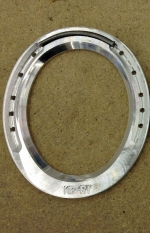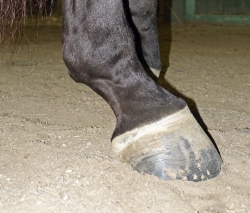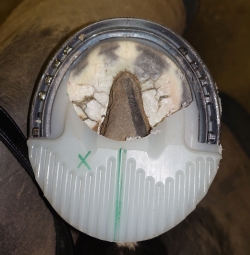The regular egg bar shoe (Fig. 1) is essentially a therapeutic device. The extreme depth of the shoe and the wrap around the bar creates a great deal of support for the lower leg in the caudal (rearmost) portion of the hoof.
The most common use for this type of shoe would be for soft tissue injuries of the lower limb in hind legs, such as suspensory tears. It is not unheard of, though, to use egg bars on sound racehorses as well. This is usually done in situations of extreme interference problems of hind legs. The additional support offered by that extended bar also adds significant stopping action when a horse is at training and race speed.
While this stopping action can clean up interference, it comes at a price. Any time you stop a performance horse’s gait earlier and more suddenly, added stress to that leg is unavoidable. This is why egg bars on racehorses are usually a last-resort attempt to clean a horse up from interfering. If an egg bar is truly warranted for therapeutic support, that horse is unlikely to be racing yet in the recovery process.
Conformation is another reason for caudal support. It is possible that a relatively sound horse has less than ideal conformation, yet is still doing well on the track. Two conformation issues that beg for caudal support are sickle hocks and weak pasterns.
 (Photos by the author) Fig. 1: The regular egg bar shoe is ideal for horses with soft tissue injuries of the lower hind legs.
(Photos by the author) Fig. 1: The regular egg bar shoe is ideal for horses with soft tissue injuries of the lower hind legs.
My dilemma this past summer was how to help a horse with weak pasterns behind (Fig. 2) and yet not add as much stress as an egg bar shoe. While shoeing this horse, I noticed how much the rear legs were loading behind the heels of the hooves.
The idea I thought to try was using a flapper pad as the egg bar (Fig. 3). I was able to bring the flapper as far back in the heels as any traditional egg bar shoe. Thisalso allowed me to keep the “bar” portion of the flapper much wider than any metal shoes could ever be. I believe this is noteworthy because a wider surface area is more supportive in any situation.
My concern in doing this was how well the horse would trot while shod like that with added weight on the back feet. He went to The Meadows and was actually better-gaited, according to his trainer, Anette Lorentzon.
After racing through the summer, he came back with different hind shoes. He had on flapper pads behind. While not unheard of, it is a bit unusual. Anette actually had to remind me that we tried flappers behind before he left. My first thought was “why would I try that?”
After Anette patiently talked me into trying it once more, I (finally) saw the reason we did this in the first place: the horse had weak pasterns behind. Thankfully her memory is much better than mine. After shoeing the horse again with flappers behind actually he now had flappers on all four feet), he trotted in 1:54.3 at Red Mile. That’s a pretty good effort for a lightly raced 2-year-old.


I think three factors are important in this application: getting enough distance caudally, keeping the “bar” portion of that flapper broad enough to be supportive, and beveling the leading edge of that bar so that it doesn’t bite as hard into the track when landing. These last two elements lessen the severity that a typical egg bar would place on the limb when landing.
All in all, I think this was a successful experiment that came from keeping an open mind (both mine, and most importantly, Anette’s) and not placing all our eggs in one basket.
Veteran Standardbred farrier Steve Stanley of Lexington, Ky., authors a monthly column for Hoof Beats, the official harness racing publication of the U.S. Trotting Association. The American Farriers Journal Editorial Advisory Board member offers plenty of practical advice that will be of special interest regardless of the type of horses that you work with. Click here to read more from Steve Stanley's Hoof Beats series.








Post a comment
Report Abusive Comment